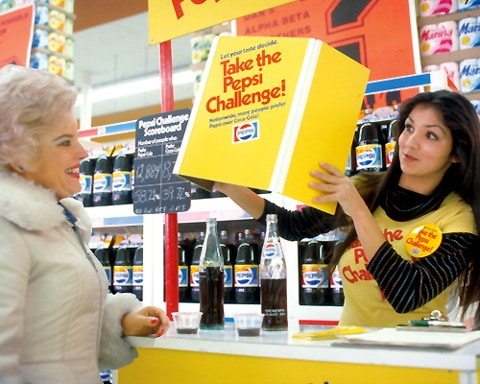
Beginning in the 1980’s Pepsi started running the Pepsi Challenge — television commercials featuring taste tests that would pit their soda versus Coca-Cola. Tasters would take sips of each unmarked beverage, and were asked to declare which soda they preferred. Invariably, Pepsi was the favorite choice. Coke conducted its own trials and astonishingly found similar results. The oft cited reason was that Pepsi’s formula was sweeter, and this led to the conclusion that Coke needed to change their formula and resulted in the disastrous roll out of the abomination called New Coke.
However, even though people blindly prefer Pepsi, people still buy Coke to the extent that it commands a much larger share of the soda marketplace than Pepsi (I’m more of a Diet Mt. Dew guy.) In tests, researchers also found that foreknowledge of the brand led to the results changing – people’s responses changed and the majority preferred Coke when they knew the brand.
Why is this? Are people totally irrational? Or are there other factors at play – childhood memories of drinking a Coke with grandpa on the front porch swing, or perhaps the warm fuzzy feelings you have from watching the polar bear commercials and the Super Bowl. Regardless, the simple conclusion is that there is more at work than simply taste, or even logic alone. Brand means something, and this applies to other items such as wine, automobiles, and clothing.
Does the same branding imprints apply to investing and stocks? Certainly – for the older investors think back to the old EF Hutton (“When EF Hutton talks, people listen”) or Smith Barney (They make money the old fashioned way, the earrrnnnned it) commercials. Or perhaps the great brands of Warren Buffett of Peter Lynch. The Pepsi challenge can provide a metaphor for high yielding dividend funds as of late. Investors love dividends, and rightfully so. Companies that pay dividends have historically outperformed the broad market in the United States, and in other countries all the way back to 1900. Since 2000, dividend-paying companies have trounced the overall markets, and sorting countries by dividends works as well.
Dividends also have a great “story”. You may have learned about them from your parents, or perhaps taking an investing course in college. Historically, when you invest in dividend stocks you are adding a value tilt to your portfolio. This is one of the reasons investing in dividend stocks works – they are value stocks. One could go as far to say dividends have a great brand. Much like Coke, thoughts of dividend stocks immediately conjures images of regular checks coming in the mail from profitable, established companies.
However, market valuations and stock and fund characteristics ebb and flow based on cycles as well as investor psychology. And while it was nearly impossible to find someone wanting to invest in dividend stocks in the late 1990’s, almost everyone you talk to currently seems to love dividends as interest rates have fallen and investors search for yield.
One useful exercise for investors is to examine their funds (mutual funds or ETFs). In the spirit of the Pepsi Challenge, you should type their tickers into the Morningstar portfolio report here. I try to stay away from mentioning tickers on the blog but you can find a list of dividend funds at ETFdb.com or certainly the Morningstar screener.
Notice that these funds are more expensive across every valuation measure (this is a generalization but true for most of the funds I examined). What most people want is solid returns and safety. But looking at these stats do you feel safe? Does it seem reasonable to be paying a higher valuation than the overall market for high yield? (Note: this may not be the case for high yield funds that have a quality and or valuation screen.)
In addition to overvaluation, one additional headwind for dividends is the potential interest rate environment. O’Shaughnessy found sixteen periods of rising rates in the United States since 1927. The average duration for each cycle was 25 months, where the 10 Year US bond rate change was 2.35 percentage points. The market averaged an 11.1% return over these periods (though wide dispersion from 40.9% to -45.9%). However, the high yielding dividend bucket underperformed the market by 2.6% compounded.
So with potential headwinds of valuation and rising interest rates, why do investors still invest in dividend funds when they could be investing in something else? There are a few possibilities. For many investors they simply may not be aware of the characteristics of their funds, and they may simply assume a high yield strategy confers a value tilt. Other investors probably prefer the high dividend funds for the same reasons they prefer Coke – they are familiar with dividends. Perhaps they think back to getting burned by non-dividend stocks in the 2000 tech bubble – or maybe they recall talking to their parents around the kitchen table as a child. Making the best investment choice requires a separation of logic and emotions.
Enjoy the old broker commercials below!

